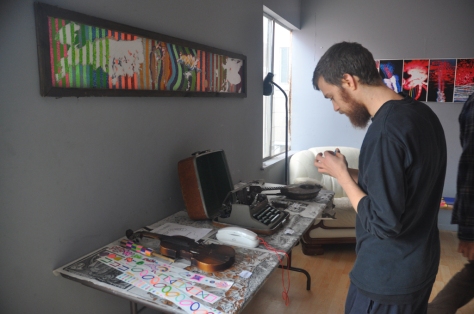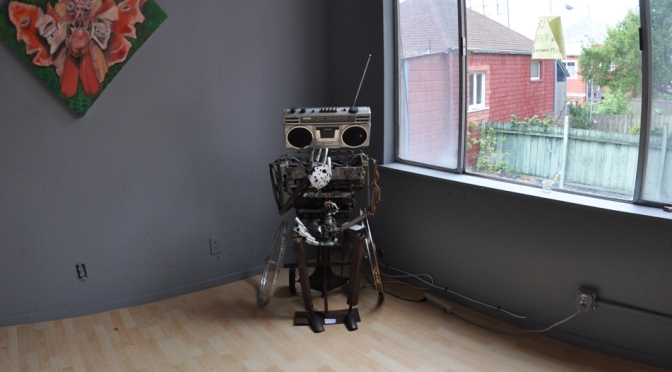Mario Garcia
Contributing Writer
With an exterior painted with yellow bees, the Honey Hive Gallery at 46th and Judah grabs the attention of passersby. Inside there is an art space covered in works by local artists. Behind the art gallery, a modest room with a PA system is a space for performances.
The manager, Danny Berliner, who lives above the gallery, took over the Honey Hive in early 2014 and was motivated by community support he was receiving to keep the gallery running. Berliner believes the Honey Hive, like the co-op grocery store, locally owned businesses, and community garden in the area, provides a service to the neighborhood.
The Honey Hive is one of the few places where less-established artists and performers can attract an audience in San Francisco. San Francisco is a lucrative market for big artists and performers. However, behind the scenes, the city is going through a housing crisis which has affected creative locals. Rising rent has forced many artists to different parts of the Bay Area or even other cities. San Francisco has no signs of slowing down as a large media market, but Berliner and other local arts supporters are fighting to fight to keep a local artistic culture here in San Francisco.
Artists and musicians have to make themselves known by establishing a following and this usually means starting out playing small weeknight shows or showcasing work at a coffee shop until something starts building. This is why Berliner opened the door of his gallery to any local artists. He hopes that his DIY approach to the gallery brings together a community of fans to support the local scene. “It’s important to showcase local and up and coming artists because they are not a whole of places left in the city that seem to do that,” he said. “The places that are left, some of them seem to be a little bit too upscale or generally expensive.”
Victor Valle is a media and communications studies double major at USF. In his opinion, “There’s no DIY environment, but there’s a flourishing DIY culture.” What he means is that there are many artists and musicians that commit to a DIY way of approaching their work, but Valle thinks the city does not provide the resources necessary to support DIY. Valle started Counter Culture Artist Management as a reaction to the music industry practices he observed through his jobs and internships. To Valle, artists and musicians working for companies are left with only a small portion of the cut and he believes DIY cultures try to resist this.
Both Berliner and Valle believe that a DIY culture needs to exist for local artists to grow. Valle was one of the founders of Bridgetown DIY in La Puente, Calif. where he learned about the positive impacts of building a music scene around DIY culture. Berlin hopes to replicate that kind of scene at Honey Hive.
What DIY cultures force participants to do is get creative with the material they have at hand. For example, they create temporary exhibits in a local shop or put on shows in the basements of houses because they do not have access to established clubs and galleries.
The city’s Entertainment Commission issues permits for performance spaces and entertainment venues. The members that make up the commission come from different sides of the entertainment industry such as bars, music, nightclubs, theaters and media. The Honey Hive Gallery received a “limited live performance” permit from the commission. The terms of the permit allow the gallery to hosts shows until 10 p.m., but it cannot sell alcohol or rely on live performances as its sole source of income.
Berliner believes the limited permit is the right step in allowing smaller places to host shows. Compared to a typical $2,000 venue permit, Berliner only had to pay $400 and the regulations are not as strict as those for a regular performance permit.
Lucas Nevrla is a member of a local punk band called WAG. Nevrla helped organize basement shows as part of the punk community in New Hampshire. He admires the scene he is part of in San Francisco, but cannot stop worrying about rising rents. “It scares away and makes a lot of young artists not want to live here anymore which is a loss for the city,” said Nevrla.

Valle joked, “There is no such thing as a San Francisco artist anymore.” Valle noted his exaggeration but was quick to point out that many of his creative peers have migrated across the bay because of costs. The artist’s plight of struggling to survive in San Francisco was brought to a mainstream consciousness when John Dwyer, the force behind Thee Oh Sees, left San Francisco for Los Angeles and wrote a public letter condemning the rapidly gentrifying city. Many local artists were quick to denounce the “whiny” tone and nature of the letter, but also related to the struggle behind it. Despite the challenges, there are still participants like Lynn Schwartz who are proud to keep San Francisco a cultural center. Schwartz co-owns Bottom of the Hill club, which is a recognized name not only in San Francisco, but also around the United States. Schwartz said, “We always feel like we are one lawsuit or neighbor complaint away from closure.” However, she also recognizes that Bottom of the Hill succeeds because of her staff’s work ethic and the support and turnout she has received over the last decades from San Francisco music fans. Large entertainment groups such as AEG and Livenation have a presence in San Francisco, but Schwartz said she is proud that, “We (the fan community) didn’t sell out our music scene to the highest bidder, and that’s so San Francisco.” Bottom of the Hill attracts numerous large touring bands, but because it is independent, Schwartz and staff have the freedom to host a variety of local bands, which she calls the “backbone” of the club.
Chad Heimann, a USF media studies alumnus, is the talent buyer and brand manager for local indie music, film and arts festival Noise Pop. Heimann is critical of the perception that people in San Francisco don’t support the arts. “People want to focus on the negatives and they do not really focus on the positives with the new venues that exist in the city,” said Heimann. He notes the Chapel in the Mission District and Leo’s in Oakland as exciting newer venues. He also believes that San Francisco always has something new to offer in terms of bands and genres.
Berliner is determined that the Honey Hive Gallery will be there to provide a showcase for little-known San Francisco artists.
Photo courtesy Mario Garcia

